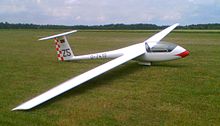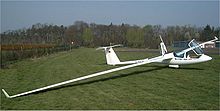Gliding
Gliding (also known as gliding) is an aerial sport that consists of flying an aircraft without an engine, commonly called a glider and also a sailboat. Different methods are used to put the plane into flight, called "launching", the most used today being towing by winch and towing by plane. Normally, its pilots are capable of making the glider gain altitude, that is to say, rise without any help other than the movements of the air masses within the atmosphere, once disengaged from the launch method, these movements being normally of three types::, Hillside, Wave, Thermal.
History
Although there are numerous precedents for gliding flight, Otto Lilienthal is considered the father of gliding. However, the true beginning of this sport takes place in Germany in 1920, with the first glider contest held at the Wasserkuppe. Germany is still today the country where there are more practitioners and where more technical innovations are produced.
Gliders were launched at the very beginning of the sport, in the 1920s and 1930s XX, from high above of a hillside aided by a system of elastic bands. Sailboats are currently raised towed by an airplane or by a winch, which is a motor that winds a cable hundreds of meters long to which the sailboat is attached and that it can release when it reaches the desired height or the vertical of the winch. Upon reaching the desired height, the sailboat is unhooked from the cable that connects it to the plane or the winch and continues its flight.
Technique
A sailboat is an aircraft without an engine, so it is always descending. For this reason, in all modalities of gliding, ascending air masses are sought, which make the sailboat rise because they rise more than what the machine naturally lowers. An example: imagine a glider moving at 100 km/h and falling one meter every second (1 m/s), but the pilot manages to stay in an updraft of 5 m/s for 60 seconds: he will have gained 240 meters and will have traveled just over 1.6 km.
The basic modalities of gliding are thermal, slope and mountain wave. In the thermal flight, thermal currents produced by the differential heating of the ground by the Sun rise in the atmosphere, in such a way that with the glider we try to stay inside it to go up (usually, turning inside them). In the slope flight, the wind that hits more or less perpendicular to a slope is forced to rise. If the slope is large enough and the wind is well oriented with enough force, a sailboat positioned in the best position can fly leaning into the wind without losing altitude or even rising.
Lastly, the mountain wave is a more complex phenomenon that occurs in the lee of mountain ranges affected by a strong wind. This wind causes a wave phenomenon beyond the mountains, in which, under certain conditions, it is possible to fly and reach great heights.
Regulations
Each country has its regulations to obtain the necessary license or permit to fly gliders. In addition, there are titles or diplomas internationally recognized by the International Aeronautical Federation ([1]) for certain achievements. These currently begin with the "C" silver, which requires having achieved 1) a distance in a straight line of at least 50 kilometers 2) a height gain of 1000 meters and 3) a stay in the air of at least 5 hours. The old titles A, B and C fell out of use years ago as gliders became capable of ever higher performance. Other titles such as the C de oro and diplomas (for example, 1000 kilometers) are designed to recognize more difficult flights.
Gliders
A simple measure of a sailboat's performance is the glide ratio. This is a measure of the maximum distance a sailboat can glide under optimal conditions, from a given height. Thus, a glide ratio of 30:1 indicates that the sailboat can (theoretically) glide 30 kilometers from a height of 1 kilometer (1000 meters). In real life, there are many factors that influence this distance (wind in favor or against, state of the atmosphere, cleanliness of the plane, to name a few). In addition, it is not the only interesting characteristic of the plane when considering its performance. However, it is an easy to use and widely recognized measure.
Early gliders were made of wood and covered in fabric. The technical advances since the inception of the sport can be summarized in three stages: 1) wooden sailboats with progressively more and more aspect ratio and aerodynamic fineness, endowed with classic airfoils, culminating in the late 1930s with sailboats that had coefficients glide ratio of approximately 30:1. 2) In the 50s, laminar profiles were applied and developed, progressively increasing the performance of sailboats up to glide ratios of more than 40:1. 3) At the end of the 60s, the construction of composite materials (fiberglass and plastic, later also carbon fibers and Kevlar) became general, which allowed to obtain much cleaner aerodynamically clean flight surfaces, reaching the maximum glide coefficients of 60-70:1 of today's most advanced sailboats.
A slightly more complete measurement is the "polar" of the sailboat, a curve that indicates, for each speed with respect to the wind, the rate at which the sailboat sinks, therefore it also indicates what is the maximum coefficient of glide. Currently, sailboats with a fairly flat polar area are appreciated, that is, they maintain a low sink rate for high speeds (200 km/h or higher).
The interest in observing the polar of a sailboat comes from the fact that two different sailboats can have a glide coefficient of 30:1 at a speed of 90 km/h, but if one of them has a coefficient of 25:1 at 150 km/h, while another has a ratio of 20:1 at this speed, we will prefer the first, since it allows us to move faster while losing less height, which is very useful, among other things, to stay in currents for a short time descendants.
Types of gliders
Throughout the history of gliding there have been three types of gliders:
1.º Primary gliders, used for training, have a central frame to which the wings and the stabilizing and control devices are attached. The pilot sits in an unprotected seat, in front of the frame. These are currently in disuse, except for the old glider circuits. Example: Schulgleiter SG-38
2.º Sailboats that are built like ordinary airplanes with a fuselage and a normally closed cabin for one or two people. They are designed to achieve maximum aerodynamic efficiency. The two-seats are the ones that are normally used for flight teaching. Previously they were built of wood, plywood and fabric (wings and tail) and metal tubes and fabric (fuselage). Many of these are still in flight. For about 40-45 years, however, they have invariably been built based on synthetic structures, Fiberglass integrated into Epoxy Resins. Within these, versions with a retractable motor have appeared in recent decades, either the so-called "turbo" (they cannot take off on their own, only recover from low altitude or hold) or the "autolaunchers" o "SL"=Self-Launching that can take off on their own, being able to retract the engine into the fuselage, usually behind the cockpit.
3rd Cargo gliders are designed for military or civil use. They are large ships designed to carry heavy weights. They are built not to be soared, but to be towed in groups behind a powerful aircraft to increase the aircraft's load. The great advantages of this type of glider are its ability to carry large loads and its flexibility to land at a low speed that allows them to descend in spaces that are too restricted for common aircraft. These were used in large numbers, especially by the allies, in the Second World War. Currently in disuse due to the helicopter.
Current state
Nowadays the limits of gliding have been extended to borders unimaginable a few years ago. An example: the German Klaus Ohlmann overcame the 3000 km barrier in 2003 (a single flight, daytime, without a motor) with a free distance flight using three turning points, in a Schempp-Hirth Nimbus 4DM. The flight was carried out starting from Chapelco, Argentina, and flying mainly in waves. It is considered the practical limit of current technology.
Contenido relacionado
Paper dome
Daihatsu Terios
Second Industrial Revolution




